
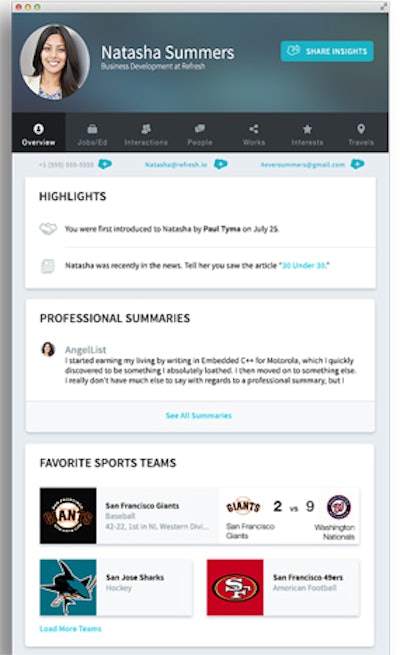
Planners interact with dozens of people—vendors, speakers, sponsors, and others—in the months leading up to an event. Refresh is a Web and mobile app that provides background information on people before a meeting to facilitate better engagement. Users link their calendars to the app and then the system searches public information from more than 100 sources around the Web, including Twitter, LinkedIn, Facebook, Yelp, and Instagram, about people they will be meeting. Users receive insights such as shared interests, work history, and recent blog posts. The system can also be used to store notes about people after a meeting.

Sponseasy allows planners to create professional sponsorship proposals in minutes. Organizers input information about the event, demographic information about the audience, and the various options for sponsorships. The look of the proposal can also be customized with pictures, colors, and effects. Planners distribute the proposal to potential sponsors by sharing a link. During the campaign, planners can track activity through the system’s online dashboard. In July the company announced a partnership with Eventbrite to allow them to import their event information. The system is currently free to use in beta.
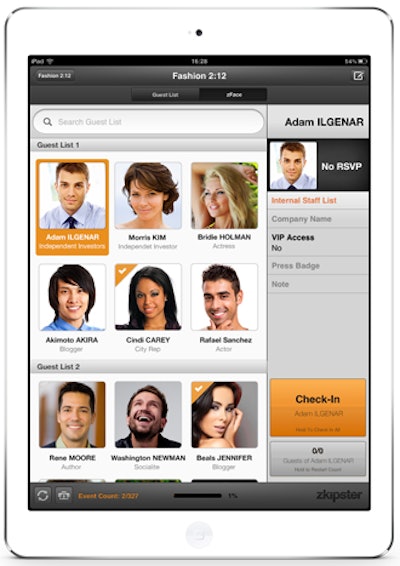
Zkipster is an app to manage check-in at non-ticketed events. In 2014 the company added several optional tools. Zface creates a photo-based guest list by searching the Internet for each guest name and pulling as many as 10 photo suggestions. Planners also can manually upload photos. The pictures are stored in a secure Zkipster account so they can be accessed for future events. Zsocial allows hosts to identify and connect with social media influencers at their event by integrating Twitter and Instagram handles into the guest list. As guests check in, the system can send them an automated welcome message that provides the event hashtag. After the event, Zsocial allows hosts to monitor and pull reports on social media interactions regarding their event. Zprint provides instant printing of name tags by connecting the app to a wireless printer.
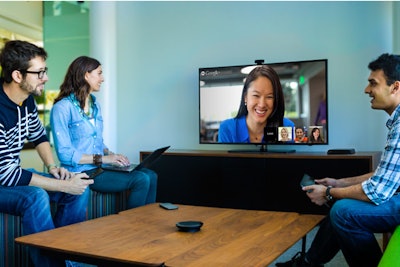
Google Chromebox for Meetings is a videoconferencing system based on Google Hangout technology. Hardware includes a Chromebox unit from either Asus, HP, or Dell, a high-definition camera, a combined microphone and speaker unit, and a remote control. As many as 15 participants can join the video meeting from other conference rooms or their laptops, tablets, or smartphones. One click of the remote starts the meeting without the need for access codes. The system is integrated with Google Apps, so invitations can be sent directly through Google Calendar. The system starts at $999.

Loopd is a system that uses Bluetooth low-energy beacons to provide a variety of location-tracking tools for planners and attendees. Beacons placed around the event communicate with chips the attendees wear on a lanyard. As guests visit exhibitor booths, attend education sessions, and meet other attendees, the system tracks those movements and saves the information. At any time, guests can log into the Loopd app to see a history of those interactions, as well as receive marketing materials from exhibitors they visited. Booth staff also receive traffic information and can follow up with attendees. For networking, users can tap their badges together to share their contact information; otherwise, the system will automatically collect data when two people are standing near each other for a predetermined amount of time. Planners receive real-time information about traffic flow and also data regarding retention, engagement, dwell time, and amount of connections made for attendees and exhibitors. The company plans to release an update in February.
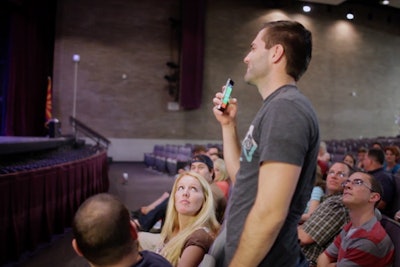
Crowd Mics turns guests’ smartphones and tablets into wireless microphones, so they can be heard over the sound system in a meeting room or auditorium. Guests download the Crowd Mics app and enter a code to join the event. When they want to ask a question or make a comment, they tap their phones, and the presenter will see a list of people requesting to speak in the order they came online. The presenter can enable an individual microphone, mute a microphone, or put the system in “open mic” mode so anyone can comment. Audience members can also submit text comments to the presenter through the Crowd Mics app, and the system offers polling functions.
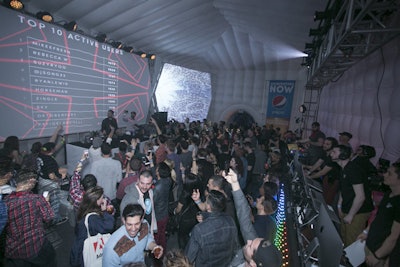
Lightwave has created sensor-equipped wristbands that measure the wearer’s biometric data, such as movement and body temperature. The technology debuted at a Pepsi-sponsored music event at South by Southwest in March. The data is transmitted wirelessly to the Lightwave system, which allows organizers to make adjustments in real-time. “For example, we thought the lighting and projections would be very engaging, but actually the environment was too bright. So when we noticed the accelerometer readings were not where we wanted them to be, we dimmed the lights and suddenly people started dancing more,” said Rana June, Lightwave founder and C.E.O. After an event, Lightwave provides data such as which moments got the most reaction from attendees or those that caused a lull in the room. Hosts also can choose to send guests their personal data to share on social networks.

Highfive is new video conferencing system from two former Google engineers. For $799, users get a sleek device that can sit on top of a television or mount to a wall and includes a video camera, microphone array, and HDMI and Ethernet connections to connect to the Highfive online system. Users initiate a video call through the system’s app or browser and send the URL to as many as 10 other participants. Using Bluetooth low energy, the system recognizes if participants are in a room with a Highfive device and then, by swiping across their smartphone screen, the video transfers to the television in the room—without cables. The system also automatically displays video of the person talking.
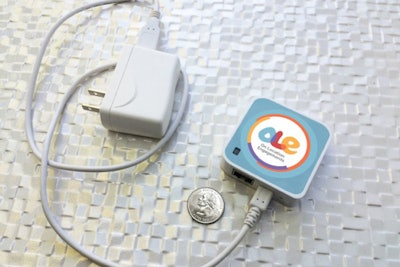
On Location Engagements is a location-based content delivery system for events. Beacons placed throughout a venue “wake up” smartphone screens when attendees are within a designated range, which can be anywhere from 5 to 30 feet. Planners determine what content is transmitted by each beacon, such as maps, videos, surveys, product information, or sponsor materials. Planners also can turn certain beacons on or off to guide an attendee through an event based on that person's job title, marketing objectives, or other goals. Attendees can create their own tour based on what interests them most by entering key words. When a tour is selected, only the beaconed zones associated with that tour would appear on the map. After the event, planners receive data such interactions per beacon, length of stay at each beacon, and traffic patterns at the venue.
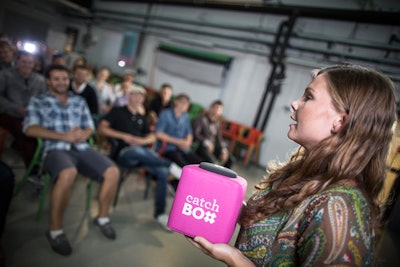
Catchbox is a wireless microphone to pass—or even throw—among speakers or audience members. The device consists of a microphone capsule secured with a magnet inside a soft, colorful cube. Catchbox communicates with an included receiver that can be connected to any sound system. To avoid unwanted noises, internal sensors mute the microphone when the cube is in motion. The company has two products: Catchbox 2.4 for groups of as many as 100 people no more than 100 feet apart and Cathbox Pro for an unlimited number of people within a range of 1,000 feet.
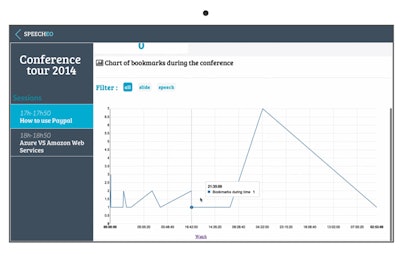
Speecheo is a new online tool for presentations designed to make it easy for audience members to take notes and also reveal to speakers and planners the most popular parts of their presentations. Attendees can view presentation slides and materials on their mobile devices and take notes alongside them. They can also capture audio and create bookmarks, so after the presentation they can review specific parts and share them on social media. Speakers and planners receive detailed analytics regarding which parts of the presentation were the most captured and shared. The system is currently in beta testing. The company expects to launch the public version in January.
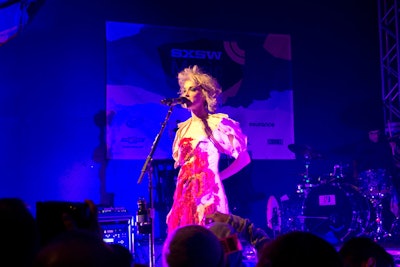
Where/when: Austin, Texas; March
Type of offerings: Music, film, and digital media
2014 dates & ticket prices: March 7-16; admission prices start at $495
Vibe: Crowded, celebratory, frenetic, and keyed in to all things media—especially music, given its origins as a music fest. The significant presence of many start-ups adds dynamic energy throughout the event, and a hipster sensibility pervades venues throughout the city.
Audience: The 2014 iteration drew an estimated 150,000 people, who turned out for all or part of the 10-day program. Among the ranks are mostly twenty- and thirtysomethings, with more than one in 10 traveling from abroad. It leans more heavily toward male attendees—about 60 percent to 40 percent female.
Past event hosts: USA Network, 3M, Beats by Dre, Sonos, Filter, Fader, MySpace
Past main event sponsors: Chevrolet, Friskies, American Airlines, Oreo, Yahoo, Smirnoff, Taco Bell, SideCar
What works: Media-, music-, tech-, and innovation-heavy parties and activations are right for this crowd—last year 3M even used a disturbingly lifelike digital avatar named Jenny that directed guests to panels and events at the Austin Convention Center. Official and unofficial events take over hotels, restaurants, and nightclubs throughout the city.
What doesn't work: Events without a surprising interactive element—or another obvious draw like headlining entertainment—will have trouble rising above the noise.

Where/when: Miami; March
Type of offerings: Electronic dance music
2014 dates & ticket prices: March 28-30; admission prices start at $399.95
Vibe: Ultra feels like an eclectic costume party. Scantily clad attendees from all over the world offer plenty of people-watching opportunities. It attracts newbies and longtime festival vets alike.
Audience: Last year, Ultra broke attendance records with about 330,000 people from more than 80 countries at Bayfront Park; the festival also attracts a number of college-age spring breakers.
Past event hosts: Absolut, SiriusXM, Belvedere, Red Bull
Past main event sponsors: Heineken
What works: Pool and yacht parties, private warehouse bashes, and nightclub events start after the festival’s official daily curfew. Record label parties are a huge draw, allowing guests to check out DJs and related talent. An electronic music component is essential to grab attention.
What doesn't work: Ultra doesn’t have an especially upscale feel—folks are dressed casually in neon and high-tops—so events that feel too dressed-up aren’t the right fit. Morning events are a definite no-no for the late-night crowd.
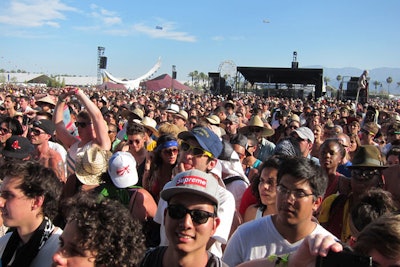
Where/when: Indio, California; April
Type of offerings: Music and art
2014 dates & ticket prices: April 11-13, April 18-20; admission prices start at $375
Vibe: Generally peaceful, joyful. Think braids and daisy garlands amid a free-to-be atmosphere. There’s an air of concern for the environment: interactive recycling programs draw heavy crowd participation.
Audience: A generally sold-out crowd blanketing Indio’s vast Empire Polo Club comprises mixed-genre music fans, many traveling from Los Angeles to the three-day-long program that repeats on consecutive weekends. The range of ages and interests appeals to marketers in the categories of fashion, media, and beverage. Last year drew 90,000 three-day ticket holders for each of the two weekends, and this year is sold out as well.
Past event hosts: Lacoste, Armani Exchange, T-Mobile, Guess, ShopBazaar, H&M, Chevy Volt
Past main event sponsors: Heineken, H&M, JBL, PlayStation, Red Bull, Fruttare
What works: With the desert heat often soaring well above 100 degrees, pool parties reign supreme. The parties often take over private residences and hotels on the festival grounds as well as in neighboring Palm Springs, Cathedral City, and others. With the music-minded crowd, live concerts are often the centerpieces, though festival host Goldenvoice has restrictions on performances by its official acts.
What doesn't work: Daytime events without a pool component—the weather is too unforgiving. Second-weekend events aren’t as popular, so brands overwhelmingly prefer the buzzier first weekend.

Where/when: Manchester, Tennessee; June
Type of offerings: Music, art, film, and comedy
2014 dates & ticket prices: June 12-15; admission prices start at $234.50
Vibe: The festival draws a crowd with overtly artsy and environmentally friendly sensibilities. There’s a sense of community and an eagerness to explore the festival footprint and its campgrounds throughout Great Stage Park, a 700-acre event ground.
Audience: The Superfly Presents-produced Bonnaroo draws a crowd of about 80,000, including older attendees who have been around since the festival’s beginnings in 2002, to college-age kids from around the country.
Past event hosts: Fuse
Past main event sponsors: State Farm, Ford, Ben & Jerry’s, Dell, Garnier, Miller Lite
What works: Events held at night are a great match for the festival, where the masses are camping and make for a captive audience on the grounds. And given the Tennessee summer heat, giveaways that help keep attendees cool are favorites.
What doesn't work: The crowd doesn’t fancy itself as cool as, say, the Coachella kids, so events that feel exclusive are less likely to make an impact.
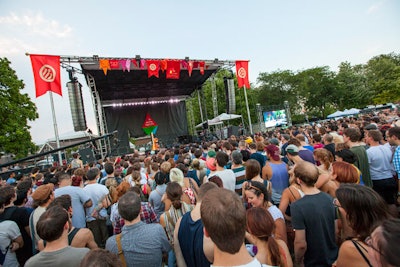
Where/when: Chicago; July
Type of offerings: Music and a retail media fair
2014 dates & ticket prices: July 18-20; admission prices start at $60
Vibe: Set in Chicago’s Union Park, the festival feels a little calmer than Lollapalooza, which shares its host city. It’s smaller and therefore easier to traverse. Headline performances draw a bigger crowd, whereas daytime events have a more relaxed vibe.
Audience: With affordable ticket prices for a major festival, Pitchfork is able to draw a broader audience. The festival also feels more intimate with about 18,000 attendees per day. Think indie music lovers and people wanting to discover up-and-coming bands.
Past event hosts: Ray-Ban, Threadless
Past main event sponsors: Vans, Hostess, ZipCar, Heineken, Goose Island
What works: Brands tend to draw in consumers with perks like icy treats, snacks, cell phone charging stations, and other essentials for staying comfortable at a hot music festival. H&M even brought in deodorant in 2012.
What doesn't work: Sponsor signage on the festival’s stages was a no-go in 2013, so sponsors used everything from carnival games to reps dressed as Twinkies to draw attention.

Where/when: Chicago; August
Type of offerings: Music, food, and retail
2014 dates & ticket prices: August 1-3; admission prices start at $95 (based on 2013 one-day passes)
Vibe: The atmosphere is festive, crowded—the event drew a record 300,000 attendees in 2013—and subject to Chicago’s unpredictable elements. It’s known to rain on the hot late-summer festival, creating a devil-may-care environment with attendees sloshing around in mud.
Audience: Young and with diverse musical genre interests: fans come to see indie, hip-hop, dance, R&B, and even country acts. But many attendees weren’t even born when some of the festival’s headline acts like Nine Inch Nails and the Cure were topping charts. The crowd is also international: At least one in 10 attendees travels from abroad.
Past event hosts: Belvedere, Gilt City, Fiji Water, Billboard, Asos, Bed Head
Past main event sponsors: Red Bull, Bud Light, Samsung, BMI, Toyota, Citi, Mophie, Gap, Hard Rock Hotel
What works: Given the festival’s urban downtown environs in Chicago’s Grant Park, hotels are popular—and proximate—venue choices for parties. And hotels welcome the event business and tourists: the festival has an economic impact of $120 million on the city.
What doesn't work: Overcrowding at related events is a perennial problem, and long lines have created headaches for guests and hosts alike. Further, Chicago’s notoriously dicey August climate has led to cancelations and last-minute tweaks (including an evacuation of the grounds in 2012).

Where/when: Austin, Texas; October
Type of offerings: Music, food, and art
2014 dates & ticket prices: October 3-5, October 10-12; admission prices start at $200
Vibe: The festival feels buzzy and big; in 2013, back-to-back weekends drew 375,000 fans. All-ages attendees contribute to an agreeable atmosphere: Frisbee throwing, kids’ activities, and juggling are mixed in with the music offerings at Zilker Park..
Audience: Austin City Limits draws the young audience that you’d expect at a music festival, but more than a quarter of its attendees fall into the 35-to-44 age bracket. There’s even an “Austin Kiddie Limits” area to accommodate families. A third of attendees are local to Austin.
Past event hosts: Pizza Hut, Viacom, Tito’s Handmade Vodka
Past main event sponsors: Bud Light, Samsung, Honda
What works: For off-site events, festivalgoers are attracted to the comforts they don’t find on festival ground: amenities, places to sit and relax, and free food and drink. Free barbecue—and even free tattoos—are popular event offerings. Because of the festival’s strict 10 p.m. curfew, after-hours events have a good bet at drawing crowds.
What doesn't work: Traffic is a huge challenge to and from the festival venue, so hosts that choose locations too far away have it tougher when trying to pull attendees.



















